<< Learning Center
Media Accessibility Information, Guidelines and Research
Captioning Types, Methods, and Styles
During the late 1950s, only open-captioning was available. It was not until 20 years later that closed-captioning made its first debut. Several years later, other captioning techniques followed.
What Are "Captions"?
Captions are the "audio" for deaf and hard of hearing people. "Captions" is basically another word for "words," and they are usually placed at the bottom portion of the screen. Captions enable deaf and hard of hearing people to understand and enjoy the dialogue the same way as hearing people do.
What Are "Types"?
Types vary according to how the captions appear, how they are accessed, and what information is provided. These include closed captions, subtitles, and subtitles for the deaf and hard of hearing.

Closed Captions
These are hidden on the 21st line of the vertical blanking interval (VBI) of a video signal and are made visible by a decoder at the time of viewing. They are usually white letters encased in a black box. (See Figure 1.)

Subtitles
Subtitles are usually white or yellow letters with a black rim or drop shadow. Some are always visible, like the "open captions" of DCMP videos. (See Figure 2.) Others, like those on DVD and the Internet, are displayed utilizing the medium's menu option.

Subtitles for the Deaf and Hard of Hearing (SDH)
These are just like subtitles, but SDH includes information such as sound effects, speaker identification, and other essential nonspeech features. (See Figure 3.) These are presented as close to verbatim as possible.
Foreign Film Subtitles, which are written for hearing viewers, usually do not indicate information other than dialogue, and often are edited. Some may translate important onscreen printed information such as a street sign or a written message.
What Are "Methods"?
Methods vary according to when the captions are created and displayed. These include off-line and online.
Off-line
Off-line captions are created and added after a video segment has been recorded and before it is aired or played. Examples of programs that utilize off-line captioning are prime-time TV programs, made-for-TV movies, and educational media. (Live Display captions are created prior to airing, but the timing of the display is controlled manually at the airing, often with a teleprompter.)
On-line
On-line captions are created and displayed at the time of program origination, and sometimes referred to as Real-time. Examples of programming that utilizes on-line captioning are sporting events, newscasts, and other events that do not allow time to prepare off-line captions. (CART—Computer-Aided Real-time Translation—is on-line captioning shown on a screen projector at live events such as meetings and school activities.)
What Are "Styles"?
A style refers to the way captions are presented. These include pop-on, roll-up, and paint-on.
Pop-on
Pop-on captions are usually one or two lines of captions that appear onscreen and remain visible for one to several seconds before they disappear. A few frames of media are left without captions before the next line(s) of captions "pop-on."
Roll-up
Roll-up captions are usually verbatim and synchronized. Captions follow double chevrons (which look like "greater than" symbols), and are used to indicate different speaker identifications. Each sentence "rolls up" to about three lines. The top line of the three disappears as a new bottom line is added, allowing the continuous rolling up of new lines of captions.
Paint-on
Paint-on captions are very similar to roll-up captions. Individual words are "painted on" from left to right, not popped on with all captions at once, and usually are verbatim.
For more detailed captioning guidelines and definitions of captioning terms, check out the Captioning Key.
Tags:
Please take a moment to rate this Learning Center resource by answering three short questions.
